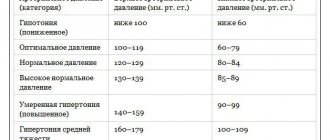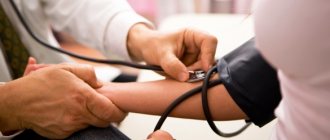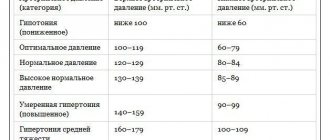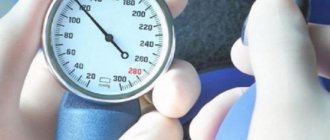Blood is connective tissue that is found in the human body in liquid form. It ensures the functioning of all internal organs and systems, circulating through the vessels under the control of the contractile function of the heart. Blood pressure (BP) is a vital indicator that determines how hard the blood presses on the walls of blood vessels. Against the background of various conditions, blood pressure levels can increase or decrease, which in some situations is considered normal, in others – pathology.
The traditional norm is considered to be a blood pressure reading of 120/80. Sometimes, when checking the pressure results on the tonometer, the numbers 100 to 50 appear. What is this condition called, is it considered a pathology, and what to do with such numbers?
Why are two numbers recorded when measuring pressure?
The heart is a hollow muscular organ that is located at the level of the third rib. Located in the center of the chest with a slight shift to the left. The right side of the heart consists of the atrium and ventricle, the left is the same. The left half of the organ supplies the internal organs, upper and lower limbs, the brain with oxygenated arterial blood, the left half collects venous blood with a large amount of carbon dioxide and facilitates its passage through the lungs to get rid of CO2 and supply oxygen.
To prevent mixing of arterial and venous blood in the heart, both halves are separated from each other by partitions. Mixing is possible only during the intrauterine life of the fetus, which is explained by a number of physiological factors. Between the atria and ventricles there are special valves that prevent blood from flowing back. The heart has the ability to work like a pump. In order for blood to move through the vessels, a certain pressure is necessary. Through arteries - arterial, through veins - venous, through capillaries - capillary.
When the heart contracts, pushing blood into the arteries, the blood pressure level is considered maximum. This indicator is called systolic, since it is recorded at the moment of systole (compression of the heart). When the organ relaxes (diastole), the second indicator is recorded - diastolic. The first is also popularly called the upper, the second – the lower. That is why blood pressure recording always has two indicators (for example, 130 over 90, 120 over 80, 100 over 55, etc.). To record in medical records, use the “/” sign, which separates both numbers (for example, 115/80). Blood pressure is measured in millimeters of mercury (mmHg).
Important! If we consider a specific pressure variant of 100 to 50, then 100 is systolic pressure, and 50 is diastolic.
Pulse
Pulse indicators with hypotension are very variable.
And also read on our website: What does blood pressure 170 to 110 mean, what to do and how to reduce high levels?
A pulse of 60 to 90 beats per minute is considered normal if it is combined with chronic hypotension, then in this case low blood pressure is not considered an indication for hospitalization, however, in some cases additional examinations are required to exclude certain pathologies.
A slight increase in pulse readings with arterial hypotonicity is also normal, as this is a compensatory reaction of the body to a decrease in blood pressure. This is how the body provides vital organs with oxygen and nutrients, since without them existence is impossible.
The combination of low blood pressure and a drop in heart rate may result from:
- high-grade blood loss;
- septic condition;
- anaphylaxis;
- states of shock;
- heat stroke;
- hemorrhages in brain tissue.
A slow heart rate with hypotension can be caused by:
- congenital characteristics;
- hypothermia;
- atherosclerosis;
- myocardial infarction;
- pericarditis;
- myocarditis;
- endocarditis;
- oncopathology;
- traumatic brain injuries;
- intoxication of the body.
Could this indicator be the norm?
It has been established that for each age there are certain normal standards. If we talk about pressure 100 to 50, then such figures are considered normal for children under the age of 13–15. And then, such diastolic pressure is considered borderline normal. If we talk about other age categories, then such blood pressure is considered a sign of hypotension - a pathological condition with a low level of blood pressure that requires correction. Experts say that it is necessary to determine the cause and correct the numbers with the help of diet therapy, massage, physical therapy, physiotherapy and herbal medicine. In extreme cases, medications are taken.
Blood pressure levels for children are lower than for adults
Equipment for AMX 50 100
The purpose of installing modules is to provide a more comfortable game experience. It is not possible to install a “rammer” here, although we recommend it very often. We offer the following equipment:
- The vertical aiming stabilizer will correct our poor gun accuracy.
- Ventilation – boosts all tank characteristics.
- Coated optics, even with good visibility, will contribute to the comfort of the game, and with our mobility, visibility is always very important.
For those whose playing style requires fast mixing, the last point can be replaced with “reinforced aiming drives.” In other cases, the previously proposed option will work perfectly.
Associated symptoms
Hypotension is manifested by a combination of various symptoms that may resemble the clinical picture of neurological, cardiovascular and other diseases. The most common signs of low blood pressure are:
- Feeling weak.
- Dizziness.
- Complaints of frequent headaches.
- The appearance of shortness of breath and lack of air.
- Decreased performance.
- Emotional lability.
- Increased sensitivity to bright lights and loud sounds.
- Pallor.
- Rapid pulse.
- Decreased body temperature.
- Sensation of pulsation in the back of the head.
In most cases, hypotension manifests itself in only one or several symptoms, so patients often attribute their poor health to weather sensitivity, fatigue at work or school, overeating, etc.
Symptoms
The manifestation and nature of symptoms with low blood pressure are individual. They depend directly on the physiological characteristics of the body, age, external and internal factors. Most often, hypotension is accompanied by the following manifestations:
- mood lability;
- darkening in the eyes and flashing “spots” before the eyes;
- nausea, vomiting;
- memory deterioration;
- occipital or temporal pain of a pulsating nature;
- dizziness and even short-term loss of consciousness;
- general weakness and feeling of chronic fatigue;
- cold extremities;
- tachycardia;
- coldness and numbness of the extremities;
- cognitive impairment;
- decreased performance;
- drowsiness;
- weather dependence.
If you are prone to hypotension and notice a feeling of heaviness in your chest, do not ignore this symptom, consult a cardiologist.
Possible consequences
Most doctors and patients believe that only hypertension (high blood pressure) can be fraught with dangerous consequences, but this opinion is completely wrong. Persistently low blood pressure numbers can also worsen a person's quality of life. First of all, it should be said that hypotension is accompanied by a slowdown in blood circulation throughout the body. This leads to a constant feeling of fatigue, decreased physical and mental activity. In persistent pathological processes, human organs receive an insufficient amount of oxygen, which can lead to the development of brain hypoxia.
And it also became known that chronic hypotensive patients over time face an aggressive course of hypertension, which is much more pronounced than in those patients who did not experience problems with lowering blood pressure at a young age. This occurs due to decreased tone of blood vessels.
Low blood pressure is observed more often in females than in males. A frequent companion to this is considered to be menstrual irregularities. It is important to refuse self-treatment in such situations and contact qualified specialists to clarify the cause of the pathology and select the optimal methods of therapy.
And also the consequences of low blood pressure can be traumatic injuries. A similar problem arises due to the fact that against the background of hypotension there may be fainting, which leads to falls, and, accordingly, fractures, sprains, and bruises. And also a complication of low blood pressure can be a stroke. All of the above confirms that hypotension cannot be considered a harmless condition.
Reasons for the fall
Often, arterial hypotension can be a consequence of a number of reasons:
In pregnant women
Hypotension during pregnancy can be caused by:
- long fixed vertical position;
- being in a stuffy, poorly ventilated room;
- taking a hot bath;
- lack of nutrients in the body due to insufficient nutrition and starvation.
In adults and elderly
The main reasons for a sudden decrease in blood pressure in adults and the elderly are considered to be:
- decrease in the volume of circulating blood in the body - for example, massive blood loss, dehydration;
- insufficiency or dysfunction of the heart muscle;
- decreased tone of smooth muscle fibers of the vascular walls;
- hypovitaminosis, vitamin deficiency;
- neuroses, depression;
- chronic lack of sleep;
- pathologies of the endocrine system;
- kidney diseases;
- congenital predisposition;
- poor weather conditions (for example, excessive air humidity, high temperatures).
In children and adolescents
Factors in the development of hypotensive conditions in young children and adolescents are:
- genetic predisposition;
- chronic foci of infectious and inflammatory diseases;
- intrauterine development disorders, birth injuries;
- lack of physical activity;
- excessive mental stress;
- overexertion, excessive stress associated with the educational process, family or personal relationships;
- insufficient intake of vitamins, minerals and trace elements into the body;
- decreased immune status.
Diagnostic methods
In most cases, patients consult a doctor if they see numbers of 100/50 (±10) mm Hg on their home blood pressure monitor several times in a row. Art., changes in heart rate (if the tonometer is automatic), with the appearance of dizziness and headache. Naturally, they want to know what this means and whether it is normal that such indicators last for a long time or occur with periodic stability.
The doctor must clarify when exactly the patient recorded the first change in pressure, which is of concern, the time of the appearance of the first accompanying symptoms. When interviewing a patient, it is important to clarify the presence of concomitant diseases, what pathologies were previously suffered, whether the patient takes any medications, etc. You should also find out if relatives have diseases of the cardiovascular system. Next, the specialist independently checks the blood pressure level with a mechanical tonometer.
Important! At the appointment, the readings may increase slightly due to anxiety, which is called white coat syndrome. Therefore, you should recheck the pressure several times and in a calm environment.
A specialist can prescribe daily blood pressure monitoring, while the patient wears a special attached device for a day or two that records not only blood pressure, but also pulse, and can even take a cardiogram. If changes are detected, you should undergo an ECG, echocardiography, rheoencephalography, electroencephalography, ophthalmoscopy (examination of the fundus).
What can you do at home?
Very small. Professional help from a doctor is required. In case of an acute attack of hypotension, you need to take a horizontal position, drink a tonic tablet (Citramon, aspirin), and eat a salty product.
It is important not to change body position too sharply; rapid movements are excluded. If the pressure continues to drop, you need to call an ambulance to resolve the issue of hospitalization or first aid.
You cannot take any medications on your own, other than those already mentioned, it is dangerous. It is unknown how the body will react. A sharp jump in blood pressure is possible, and in the case of insufficiently elastic vessels, a stroke.
First aid and recommendations
If, against the background of a decrease in pressure, a person becomes ill (dizziness, fainting, etc.), a medical team should be called, but first aid should be provided before they arrive. The victim is placed on a horizontal surface without a pillow. Legs should be raised up at an angle of 45o. If a person is indoors, windows should be opened to provide fresh air, or a fan should be directed. When fainting, it is recommended to rub a few drops of lemon essential oil into your temples.
After the victim has regained consciousness, it is necessary to give him warm sweet tea, to which you can add a few drops of tonic tincture of eleutherococcus, ginseng, and Rhodiola rosea. If you have a chill, you should cover the person with a warm blanket. It is important to monitor blood pressure readings every 10–15 minutes until the ambulance arrives. The victim must not be left alone!
Forbidden:
- Give alcoholic drinks to warm you up.
- Without medical supervision, give medications with caffeine and other drugs that increase blood pressure, or drink coffee. This is explained by the fact that in some cases, hypotension can be caused by bleeding.
- Place the victim's head on a pillow.
Key Thoughts
A blood pressure reading of 100/50 can be either normal or pathological. In adults, it is often a sign of hypotension, the diagnosis and treatment of which should be carried out under the supervision of doctors. A sharp decrease in blood pressure is possible, requiring emergency care. Even if after an attack you managed to normalize your condition on your own, you should contact specialists to clarify the cause and select the optimal treatment regimen in order to prevent the development of a number of complications from the cardiovascular system and brain.
Crew training
Perks are an important part of leveling up any tank. Our task is to make the car as comfortable and efficient as possible.
We propose to train the crew in the following order:
- Commander – “The Sixth Sense”, “Repair”, “Combat Brotherhood”, “Disguise”;
- Gunner – “Repair”, “Smooth rotation of the tower”, “Combat brotherhood”, “Disguise”;
- Driver - “Repair”, “Smooth ride”, “Combat brotherhood”, “Disguise”;
- Radio operator (loader) – “Repair”, “Radio interception”, “Combat brotherhood”, “Disguise”.











